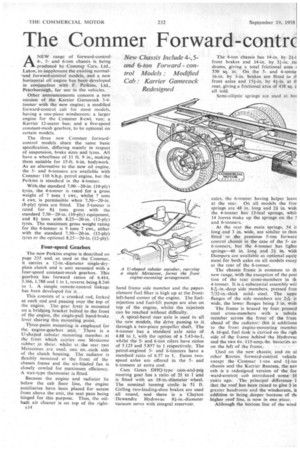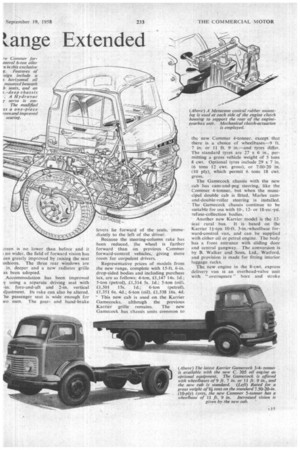The Commer Forward-contrc tange Extended
Page 100

Page 101

Page 102

If you've noticed an error in this article please click here to report it so we can fix it.
New Chassis Include 4-, Sand 6-ton Forward control Models.' Modified Cab : Karrier. Gamecock
Redesigned
ANEW range of forward-control 4-, 5and 6-ton chassis is being produced by Coming Cars, Ltd., Luton, to supplement the existing normal-and forward-control models, and a new horizontal oil engine has been developed in conjunction with F. Perkins, Ltd., Peterborough, for use in the vehicles.
Other announcements concern a new version of the Karrier Gamecock 3-4tanner with the new engine; a modified forward-control cab for most models, having a one-piece windscreen; a larger engine for the Commer 8-cwt. van; a Karrier 12-seater bus; and a five-speed constant-mesh gearbox, to be optional on certain models.
The three new Commer forwardcontrol models share the same basic specification, differing mainly in respect of suspension, brake sizes and tyres. All have a wheelbase of 1 i ft. 9 in., making them suitable for 15-ft. 6-in. bodywork. As an alternative to the new oil engine, the 5and 6-tonners are available with Commer 110 b.h.p. petrol engine, but the Perkins is standard in the 4-tanner.
With,the standard 7.00-20-in. (10-ply) tyres, the 4-ton tier is rated for a gross weight of 7 tons 1 cwt., whilst 7 tons 4 cwt. is permissible when 7.50-20-in. (8-ply) tyres are fitted. The 5-tanner is rated for 8+ tons gross with the standard 7.50-20-in. (10-ply) equipment, and 8+ tons with 8.25-20-in. (12-ply) tyres. The maximum gross weight rating for the 6-tonner is 9 tons 7 cwt., either with the standard 7.50-20-in. (12-ply) tyres or the optional 8.25-20-in. (12-ply).
Four-speed Gearbox
The new Perkins engine is described on page 235 and, as used in the Commer, it carries a 12-in.-diameter single-dryplate clutch and is unit mounted with a four-speed constant-mesh gearbox. This gearbox has forward ratios of 6.414, 3.366, 1.788 and 1 to 1, reverse being 8.246 to I. A simple remote-control linkage has been developed for it.
This consists of a cranked rod, forked at each end and passing over the top of the engine. The gear lever is mounted on a bridging bracket bolted to the front of the engine, the single-pull hand-brake lever sharing this mounting point.
Three-point mounting is employed for the engine-gearbox unit. There is a U-shaped tubular .mounting member, at the front which carries one Metacone rubber. ,in shear, whilst at the rear two Metadones are used, one on, each side of the clutch housing. The radiator is flexibly mounted at the front of the chassis frame and the six-bladed fan is closely cowled for maximum efficiency. A wax-type thermostat is fitted.
Because the engine and radiator lie below the cab floor line, the engine auxiliaries have been placed for access from above the unit, the seat pans being hinged for this purpose. Thus, the oilbath air cleaner is on top of the right El4 hand frame side member and the paperelement fuel filter is high up at the frontleft-hand corner of the engine. The fuelinjettion and fuel-lift pumps are also on top of the engine, whilst the injectors can be reached without difficulty.
A spiral-bevel rear axle is used in all the new models, the drive passing to it. through a two-piece propeller shaft. The 4-tonner has a, standard axle ratio of 4.88 to 1, with the option of a 5.43-to-1, whilst the 5-.and 6-ton oilers have ratios of 5.125 and 5,857 lo Lreipectively. The petrOl-engined 5and 6-tonners have a standard ratio of 6.57 to 1. Eaton twospeed axles are offered in the 5and 6-tonners at extra cost.
Cam Gears DI-IQ-type carn-and-peg
steering gear ha's a ratio of 21 to arid is fitted with an l&in.-;cliarneter wheel. The nominal turning circle is 51 ft. Girling two-leading-shoe brakes are used all round, and • there is a Clayton -Dewandre Hydrovac n-in.-diameter vacuum servo with integral reservoir.
axles, the 6-tonner having helper leave at the rear. On all models the fror springs are 48 in. long and 21 in. wide the 4-tanner has 13-leaf springs, whit! 14 leaves make up the springs on the .5 and 6-tanners.
At the rear the main springs, 54 it long and 3 in. wide, are similar to thos fitted to the previous 5-ton forward control chassis in the case of the 5an 6-tormers, but the 4-tonner has lighte springs-46 in. long and 2+ in. wide Dampers are available as optional equip ment for both axles on all models excep at the rear of the 6-tonner.
The chassis frame is common to th new range, with the exception of the posi tion of the rear cross-members in th 4-tanner. It is a substantial assembly witl 8-A--in.-deep side members, pressed Iron 7/32-in.-thick mild, steel. The uppe flanges of the side members are ir wide, the lower flanges being 3 in. wide
The frame is braced by four pressed steel cross-members with a tubula member across the frontof the fram ahead of the radiator'this is additiona to the front engine-mounting member A 16-gal. fuel tank is Carried on the righ side of the frame behind the Hydrovac and the two 6v. 115-amp.-hr. batteries an
on the left of the frame. .
Used on the new chassis, and On al other Rooles forward-control vehicle except the Confiner I-ton and 1+-tot chassis and the Karrier Bantam, the nev cab is a redesigned version of the far ward-control cab introduced some' 'years 'years ago; The principal difference i that the roof has been raised to give 3 in greater headroom and the windscreen, it addition to being deeper because of thi higher roof line, is now in one piece.
Although the bottom line of the wind
.:reen is no lower than before and it no wider, the field of forward vision has een greatly improved by raising the seat ushions. The three rear windows are in. deeper and a new radiator grille as been adopted.
Accommodation has been improved y using a separate driving seat with -in. fore-and-aft and 2-in, vertical djustment. Its rake can also be altered. 'he passenger seat is wide enough for wo men. The gearand hand-brake
levers lie forward of the seats, immediately to the left of the driver.
Because the steering-column rake has been reduced. the wheel is farther forward than on previous Commer forward-control vehicles, giving more room for corpulent drivers.
Representative prices of models from the new range, complete with 15-ft. 6-in. drop-sided bodies and including purchase tax, are as follows: 4-ton, £1,147 14s. Id.; 5-ton (petrol), £1.314 5s. Id.; 5-ton (oil), £1,501 15s. Id.; 6-ton (petrol), £1.351 bs. 4d.; 6-ton (oil), £1,538 16s, 4d.
This new cab is used on the Karrier Gamecocks, although the previous Karrier grille remains. The new Gamecock has chassis units common to the new Commer 4-tonner, except that there is a choice of wheelbases-9 'ft.
7 in. or 11 ft. 9 in.—and tyres differ. The standard tyres are 27 x 6 in., permitting a gross vehicle weight of 5 tons
8 cwt, Optional tyres include 29 x. 7 in. (6 tons 12 cwt. gross), or 7.00-20 in. (10 ply), which permit 6. tons IS cwt. gross.
The Gamecock chassis with the new cab has cam-and-peg steering, like the Comm.er 4-tonner, but when the municipal double cab is fitted, Manes camand-double-roller steering is installed. The Gamecock chassis continue to be suitable for use with 10-, 12or 18-cu.-yd. refuse-collection bodies. .
Another new Karrier model is the 12. scat rural bus. It is based on the Karrier 1.1-ton 10-ft. 3-in.wheelbase forward-control van, and can be supplied with either oil or petrol engine. The body has a front entrance with sliding door and central gangway. The conversion is by B. Walker and Sons, Ltd., Watford, and provision is made for fitting interior. luggage racks.
The, new engine in the 8-cwt. express delivery van is an overhead-valve unit with " oversquare " bore and stroke dimensions of 79 mm. (3.11 in.) and 76.2 mm. (3 in.) respectively. The swept volume is 1.494 litres and the compression ratio is 7 to 1, allowing the use of normal grades of fuel.
This engine, which is similar to that used in current Rootcs Group private has gross and net power outputs of 49 b.h.p. and 46 b.h.p. respectively at 4,200 r.p.m., whilst the maximum net torque of • 73.7 lb.-ft. is developed at 2,000 r.p.m., which•should give good topgear performance. An 8-in.-diameter single-dry-plate clutch drives, to a fourspeed synchromesh gearbox with stee ringcolumn gear lever.
As before, a semi-floating spiral-bevel axle is employed, this having a reduction ratio of 4.78 to 1. Independent front suspension is retained and roll stability is claimed to have been improved by the addition of an anti-roll torsion bar linking the wishbones. Standard tyres on the van are 5.50/5.90-15 in. and the grossweight rating has been increased to I ton 9f cwt.
• Kerb weight is 19f cwt..' allowing 101 cwt. for payload and driver when a passenger seat is not fitted., Although the appearance of the van is unaltered, the cab interior trim has been changed and an improved design of bucket seat has been adopted. A full-width bench seat is available as an optional extra. , The standard van sells for 1540 8s. 5d., including purchase tax.
Standard in the 12-ton tractor, and optional in the Avenger passenger chassis and forward-control 5-, 6and 7-tonners, the new five-speed constant-mesh gearbox has been designed. primarily ,for. vehicles operating in hilly territory. It has forward ratios of 7.514, 4.263, 2.374, .1.474 and Ito 1, reverse being 7.814 to I. Third, fourth and fifth gears have helical teeth for quietness and the split casing consists of magnesium-alloy castings.
The gearbox oil capacity is 20 pints and The case has one standard S.M.M.T./ S.A.E. six-bolt power take-off flange on the right-hand side. The new gearbox cannot be used in conjunction with the Commer overdrive gear, but can be specified when an Eaton two-speed axle
is fitted. Dry, the box is only 10 heavier than the standard Commer fc speed synchromesh unit and it is 20 lighter than the synchromesh model v overdrive attachments.
An oil-engined 6-ton chassis was a tested shortly before the announcerr of these new models [writes John Moon]. Brief performance figures given in the accompanying panel ant full test report will be published latei The vehicle handled well and the layout is a definite improvement on t of earlier Commer forward-com vehicles. The engine is a willing wor and because of its location under the s( does not create excessive noise in the c The gear-change linkage is positive operation and the steering, a1thot unassisted, is by no means heavy, cas action giving a comfortable degree stability.
During the brake test the hand-bn efficiency was found to be exception high, producing an average Tapley mc reading of 54.75 per cent. from 20 rn.g Emergency stops with the foot bri produced satisfactory results, the syst being powerful enough to lock all wheels, whilst the acceleration was Ns up to standard for this class of vehicle.
A brake-fade test down a 1-u gradientproduced little evidence of 1. of efficiency. A satisfactory restart v made in bottom gear facing up a 1-ingradient and the hand-bloake held t vehicle safely on this slope.
Engine accessibility was above norn for a forward-control vehicle. All I engine auxiliaries could be easily reach with the two seat cushions removed a the seat-pan traps lifted.
















































































































































































































